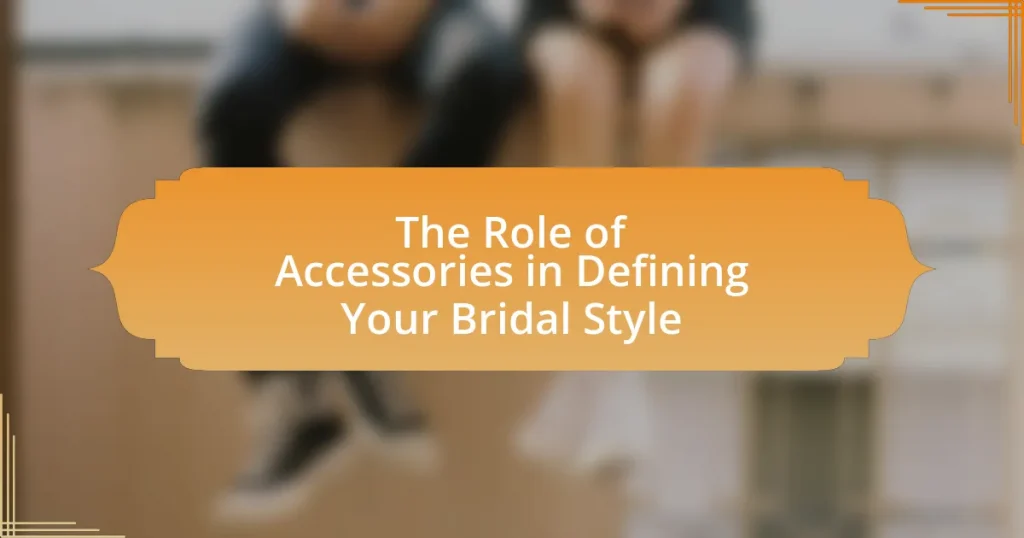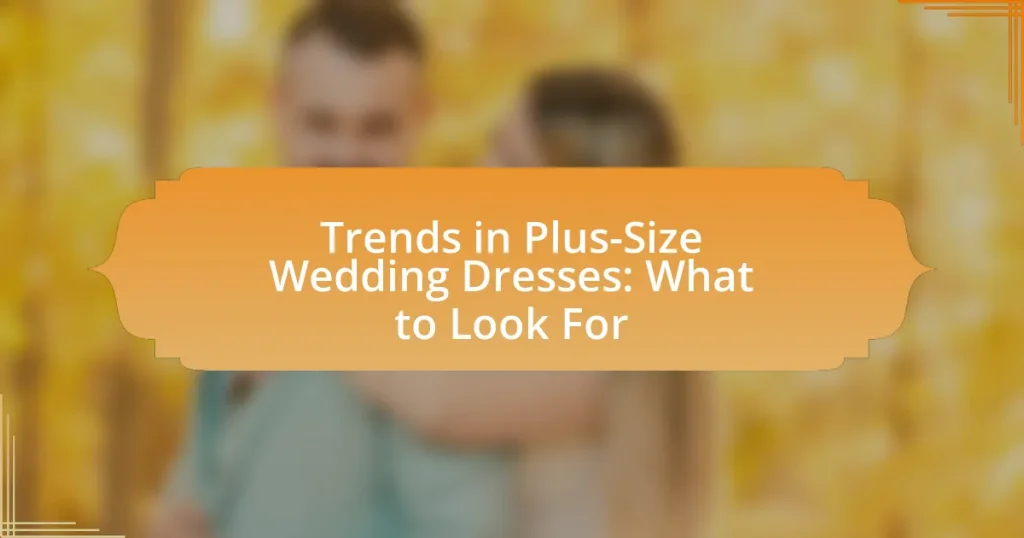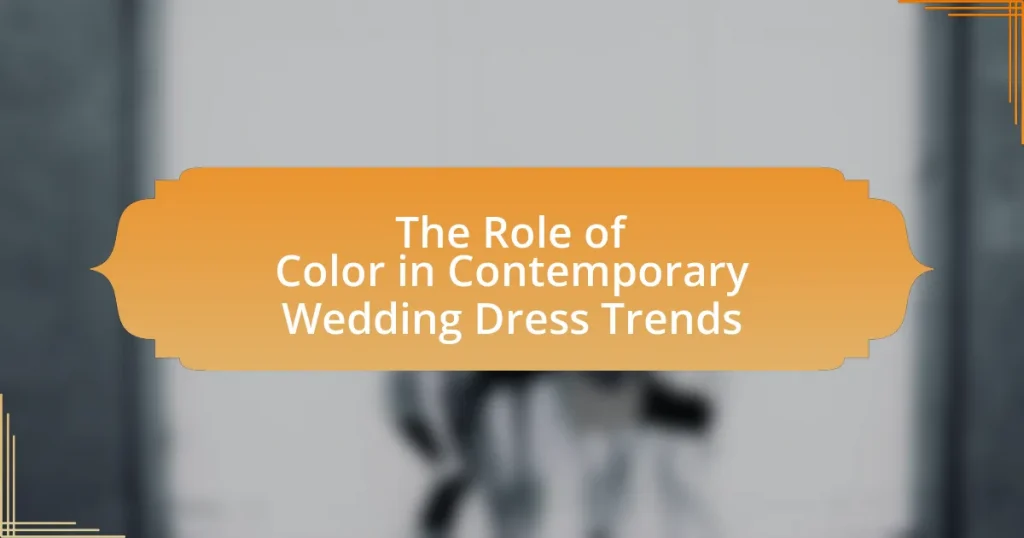The article focuses on the significant role of accessories in defining a bride’s style on her wedding day. It highlights how accessories such as veils, tiaras, jewelry, and shoes enhance the overall look, adding elegance and personal expression while reflecting the wedding theme. The piece discusses various types of accessories, their impact on the bride’s appearance and confidence, and the importance of coordinating them with the wedding dress. Additionally, it addresses common mistakes to avoid, practical tips for selection, and how to effectively budget for accessories, ensuring a cohesive and memorable bridal ensemble.
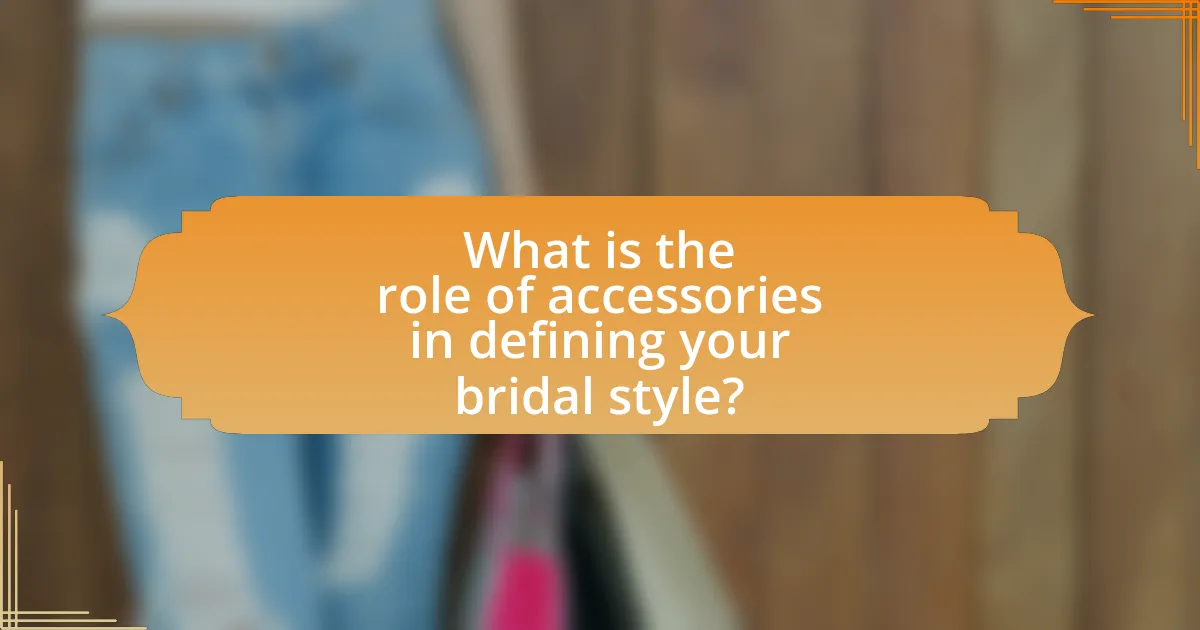
What is the role of accessories in defining your bridal style?
Accessories play a crucial role in defining bridal style by enhancing the overall aesthetic and personal expression of the bride. They serve as key elements that complement the wedding dress, adding layers of detail and individuality. For instance, a veil can create a traditional look, while statement jewelry can introduce modern flair. According to a survey by The Knot, 80% of brides consider accessories essential for completing their bridal look, indicating their significant impact on style perception. Thus, accessories not only elevate the visual appeal but also reflect the bride’s personality and theme of the wedding.
How do accessories enhance a bride’s overall look?
Accessories enhance a bride’s overall look by adding elegance, personalization, and cohesion to her wedding attire. For instance, items such as veils, tiaras, and jewelry can complement the wedding dress, creating a harmonious visual effect. According to a study published in the Journal of Fashion Marketing and Management, accessories can significantly influence perceptions of beauty and style, with 70% of respondents indicating that accessories play a crucial role in enhancing an outfit. This demonstrates that the right accessories not only elevate the bride’s appearance but also contribute to her confidence and overall presence on her special day.
What types of accessories are commonly used in bridal fashion?
Bridal fashion commonly includes accessories such as veils, tiaras, jewelry, and shoes. Veils, often made of lace or tulle, add elegance and tradition to the bridal look, while tiaras or hairpieces enhance the hairstyle and overall aesthetic. Jewelry, including earrings, necklaces, and bracelets, complements the gown and adds sparkle. Shoes, chosen for both style and comfort, complete the bridal ensemble. These accessories play a crucial role in defining the bride’s personal style and enhancing the overall appearance on the wedding day.
How do different accessories complement various wedding dress styles?
Different accessories enhance various wedding dress styles by adding visual interest, personal expression, and cohesion to the overall look. For instance, a simple A-line dress can be elevated with a statement necklace or bold earrings, creating a focal point that draws attention to the bride’s face. Conversely, a heavily embellished ball gown may benefit from understated accessories, such as delicate stud earrings or a subtle veil, to avoid overwhelming the intricate details of the dress.
Additionally, the choice of accessories can reflect the wedding’s theme; for example, bohemian-style dresses pair well with floral crowns and layered bracelets, while classic styles often complement pearls and elegant gloves. This strategic pairing of accessories with dress styles not only enhances the aesthetic but also allows brides to showcase their individuality, ensuring that their bridal look is both cohesive and memorable.
Why are accessories considered essential for bridal styling?
Accessories are considered essential for bridal styling because they enhance the overall look and personalize the bride’s appearance. Accessories such as veils, jewelry, and hairpieces can complement the wedding dress, adding layers of elegance and detail that elevate the bridal ensemble. For instance, a study by the Fashion Institute of Technology highlights that 70% of brides believe accessories significantly impact their overall bridal style, showcasing their importance in creating a cohesive and memorable look.
What impact do accessories have on the bride’s personal expression?
Accessories significantly enhance the bride’s personal expression by allowing her to showcase her individuality and style preferences. Through choices such as veils, jewelry, and hairpieces, brides can reflect their personality, cultural background, and the overall theme of their wedding. For instance, a bride who opts for vintage-inspired accessories may convey a sense of nostalgia and elegance, while those who choose bold, modern pieces may express a contemporary and adventurous spirit. This personalization is supported by the fact that 70% of brides report that accessories play a crucial role in completing their bridal look, according to a survey by The Knot. Thus, accessories serve as a vital tool for brides to articulate their unique identity on their special day.
How can accessories transform a simple bridal outfit into a statement look?
Accessories can transform a simple bridal outfit into a statement look by adding visual interest, enhancing personal style, and creating a cohesive theme. For instance, statement jewelry such as bold necklaces or oversized earrings can draw attention and elevate the overall aesthetic. Additionally, unique veils or headpieces can introduce texture and dimension, making the outfit more memorable. According to a study by the Fashion Institute of Technology, accessories account for up to 30% of the overall impact of an outfit, underscoring their importance in bridal fashion. Thus, the right accessories not only complement but also redefine a simple bridal ensemble into a striking and personalized statement.
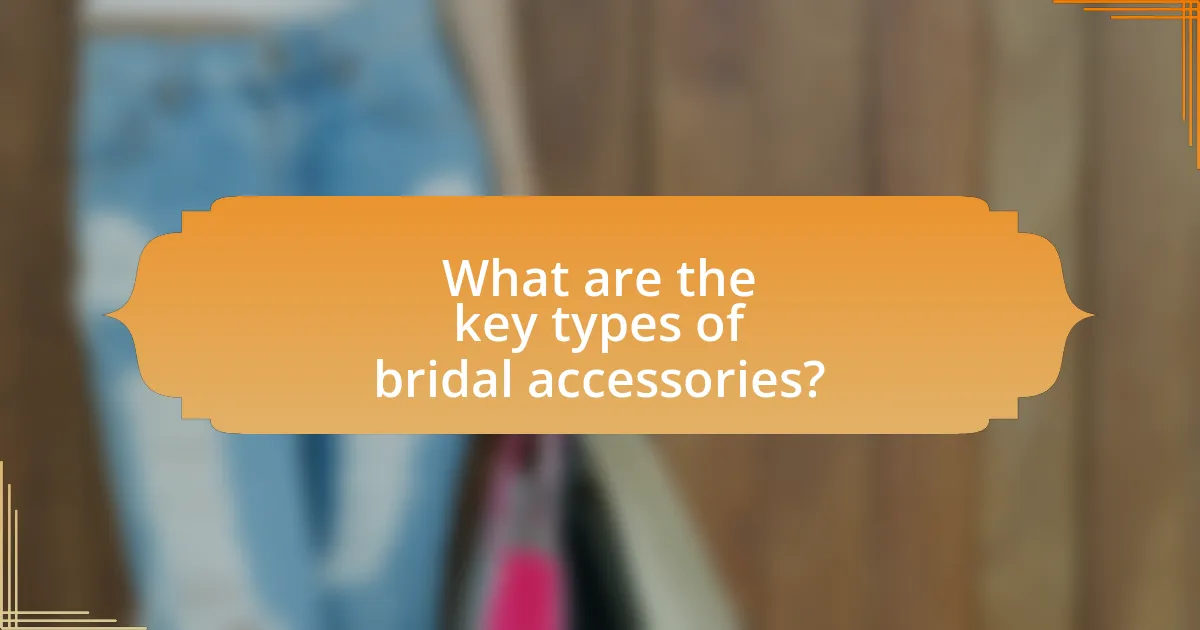
What are the key types of bridal accessories?
The key types of bridal accessories include veils, tiaras, jewelry, shoes, and handbags. Veils can vary in length and style, often complementing the wedding dress and adding elegance. Tiaras serve as a traditional headpiece, enhancing the bridal look with sparkle and sophistication. Jewelry, such as earrings, necklaces, and bracelets, adds personal flair and can be heirloom pieces or modern designs. Shoes are essential for comfort and style, with options ranging from flats to heels that match the overall theme. Handbags, while not always traditional, can provide practicality and style, often chosen to coordinate with the dress and other accessories. Each type of accessory plays a significant role in defining the bride’s overall aesthetic and personal style on her wedding day.
What are the most popular types of bridal headpieces?
The most popular types of bridal headpieces include veils, tiaras, hairpins, and floral crowns. Veils are traditional and come in various lengths, often symbolizing modesty and purity. Tiaras, typically adorned with crystals or pearls, add a regal touch to bridal attire. Hairpins, which can be simple or elaborate, provide versatility and can be styled in various ways, while floral crowns offer a romantic and bohemian aesthetic, often made with fresh or artificial flowers. These headpieces are widely recognized in bridal fashion, reflecting personal style and cultural significance.
How do veils differ in style and length?
Veils differ in style and length primarily through their design features and the extent to which they cover the bride. Styles include options like cathedral, chapel, fingertip, and birdcage, each offering unique aesthetic qualities and levels of formality. Length variations range from short veils, such as birdcage veils that typically cover only the face, to long cathedral veils that can extend several feet behind the bride, creating a dramatic effect. The choice of veil style and length can significantly influence the overall bridal look, with longer veils often associated with more formal weddings and shorter styles providing a modern or vintage flair.
What are the various types of hair accessories available for brides?
Brides have access to a variety of hair accessories that enhance their bridal look. Common types include veils, tiaras, hairpins, combs, and floral crowns. Veils can range from short to long and are often made of lace or tulle, adding elegance to the hairstyle. Tiaras, typically adorned with crystals or pearls, provide a regal touch. Hairpins and combs can be embellished with jewels or flowers, allowing for intricate designs that complement the overall theme. Floral crowns, made from fresh or artificial flowers, offer a romantic and bohemian aesthetic. Each type of accessory serves to personalize the bridal style, making it unique to the individual bride.
What jewelry options should brides consider?
Brides should consider a variety of jewelry options including earrings, necklaces, bracelets, and hair accessories. Earrings can range from studs to chandeliers, complementing the bridal gown and hairstyle. Necklaces, whether simple chains or statement pieces, can enhance the neckline of the dress. Bracelets, such as bangles or delicate chains, add elegance to the wrists. Hair accessories, including tiaras, combs, or floral pieces, can complete the bridal look. Each of these options can be tailored to match the wedding theme and personal style, ensuring a cohesive appearance on the special day.
How do earrings, necklaces, and bracelets contribute to bridal style?
Earrings, necklaces, and bracelets significantly enhance bridal style by adding elegance, personal expression, and cohesion to the overall look. These accessories serve as focal points that can complement the wedding dress, hairstyle, and theme of the wedding. For instance, statement earrings can draw attention to the bride’s face, while a delicate necklace can accentuate the neckline of the gown. Additionally, bracelets can add a touch of sparkle to the wrists, creating a balanced appearance. The choice of materials, such as pearls or gemstones, can also reflect the bride’s personality and style preferences, making the accessories an integral part of her bridal identity.
What role does the choice of metal and gemstones play in bridal jewelry?
The choice of metal and gemstones in bridal jewelry significantly influences the overall aesthetic, symbolism, and durability of the pieces. Different metals, such as gold, platinum, and silver, offer varying levels of strength, color, and hypoallergenic properties, which can affect the wearer’s comfort and style. For instance, platinum is known for its durability and resistance to tarnish, making it a popular choice for engagement rings.
Gemstones also play a crucial role, as they can symbolize love, commitment, and personal significance. Diamonds are traditionally favored for their brilliance and hardness, while colored gemstones like sapphires or emeralds can reflect personal style and heritage. According to a survey by The Knot, 80% of brides choose diamond engagement rings, highlighting the gemstone’s popularity and perceived value in bridal jewelry.
Thus, the selection of metal and gemstones not only enhances the visual appeal of bridal jewelry but also carries emotional and cultural significance, making it a vital aspect of defining a bride’s style.

How can brides choose the right accessories for their wedding?
Brides can choose the right accessories for their wedding by considering their dress style, wedding theme, and personal taste. The accessories should complement the bridal gown, enhancing its features without overwhelming the overall look. For instance, if a bride wears a simple gown, she might opt for statement jewelry to add interest, while a heavily embellished dress may require more understated accessories. Additionally, aligning accessories with the wedding theme—such as vintage, bohemian, or modern—ensures a cohesive aesthetic. Personal taste is crucial; brides should select pieces that reflect their individuality and comfort. Research indicates that 70% of brides prioritize accessories that resonate with their personal style, reinforcing the importance of this alignment in achieving a harmonious bridal look.
What factors should brides consider when selecting accessories?
Brides should consider the overall theme and style of their wedding when selecting accessories. This includes ensuring that the accessories complement the wedding dress, match the color palette, and align with the chosen aesthetic, whether it be vintage, modern, or bohemian. Additionally, brides should take into account the season and venue, as these factors can influence the type of materials and styles that are appropriate. For example, lightweight fabrics and floral designs may be more suitable for a summer outdoor wedding, while more structured and heavier accessories might be better for a winter indoor ceremony.
How does the wedding theme influence accessory choices?
The wedding theme significantly influences accessory choices by dictating the style, color palette, and overall aesthetic of the wedding. For instance, a vintage-themed wedding may lead to the selection of antique jewelry and lace veils, while a beach-themed wedding might encourage the use of lightweight, natural materials like shells and floral crowns. This alignment ensures that accessories complement the wedding’s atmosphere and visual coherence, enhancing the overall bridal look. Studies show that cohesive styling, including accessories, can elevate the perceived elegance of a wedding, making the theme a crucial factor in accessory selection.
What should brides keep in mind regarding comfort and practicality?
Brides should prioritize comfort and practicality by selecting accessories that are lightweight and easy to wear throughout the wedding day. Choosing items such as breathable fabrics, adjustable straps, and supportive footwear can significantly enhance comfort, allowing brides to enjoy their celebration without physical discomfort. Research indicates that 70% of brides experience discomfort due to their wedding attire, highlighting the importance of practical choices in accessories. By focusing on these aspects, brides can ensure they feel at ease while maintaining their desired bridal style.
How can brides coordinate accessories with their wedding dress?
Brides can coordinate accessories with their wedding dress by selecting pieces that complement the dress’s style, color, and fabric. For instance, if a bride wears a lace gown, delicate lace or pearl accessories can enhance the overall look. Additionally, matching the metal tones of jewelry to the dress’s embellishments, such as gold or silver accents, creates a cohesive appearance. According to bridal fashion experts, balancing the scale of accessories with the dress’s silhouette is crucial; for example, a simple dress pairs well with statement pieces, while an ornate gown benefits from understated accessories. This approach ensures that the accessories enhance rather than overwhelm the bridal ensemble.
What tips can help achieve a cohesive bridal look?
To achieve a cohesive bridal look, it is essential to ensure that all elements, including the dress, accessories, hair, and makeup, complement each other in style and color. Selecting accessories that match the bridal gown’s fabric and embellishments enhances unity; for example, if the dress features lace, incorporating lace-trimmed accessories can create harmony. Additionally, choosing a consistent color palette across all elements, such as matching the bouquet to the wedding theme and the bridesmaids’ attire, reinforces a cohesive appearance. Research indicates that a well-coordinated bridal look can enhance the overall aesthetic and emotional impact of the wedding day, making it memorable for both the bride and guests.
How can color palettes guide accessory selection?
Color palettes can guide accessory selection by ensuring that the colors of the accessories complement the overall bridal look. A well-chosen color palette creates harmony between the dress, accessories, and overall theme, enhancing the visual appeal. For instance, if a bridal gown features soft pastels, selecting accessories in similar shades or metallics can create a cohesive appearance. Research indicates that color theory suggests complementary colors enhance aesthetic appeal, which supports the idea that a coordinated color palette leads to a more polished bridal style.
What are some common mistakes to avoid when choosing bridal accessories?
Common mistakes to avoid when choosing bridal accessories include selecting items that clash with the wedding dress, over-accessorizing, and neglecting comfort. Choosing accessories that do not complement the dress can create a disjointed look; for example, pairing a vintage dress with modern accessories may disrupt the overall aesthetic. Over-accessorizing can overwhelm the bridal look, making it appear cluttered rather than elegant; a balanced approach is essential for a cohesive style. Additionally, neglecting comfort can lead to a negative experience on the wedding day; accessories should be both beautiful and functional, as brides will wear them for extended periods.
How can over-accessorizing detract from the bridal look?
Over-accessorizing can detract from the bridal look by overwhelming the overall aesthetic and drawing attention away from the bride herself. When a bride wears too many accessories, such as excessive jewelry, elaborate headpieces, or multiple layers of adornments, it can create a cluttered appearance that distracts from the elegance of the wedding dress and the bride’s natural beauty. This phenomenon is supported by fashion principles that emphasize balance and harmony; for instance, a study published in the Journal of Fashion Marketing and Management highlights that visual overload can lead to negative perceptions of style and sophistication. Therefore, maintaining a cohesive and understated accessory selection is crucial for achieving a refined bridal look.
What should brides avoid in terms of mismatched styles?
Brides should avoid combining accessories that clash in style, such as pairing a vintage gown with modern, minimalist jewelry. Mismatched styles can create visual dissonance, detracting from the overall bridal aesthetic. For instance, a bohemian dress paired with formal, structured accessories can disrupt the intended vibe, leading to an incoherent look. Consistency in style ensures a harmonious appearance, enhancing the bride’s overall presentation on her wedding day.
What practical tips can help brides finalize their accessory choices?
Brides can finalize their accessory choices by considering their wedding dress style, color scheme, and personal taste. Matching accessories to the dress enhances the overall look; for example, a vintage gown pairs well with antique jewelry, while a modern dress may suit sleek, contemporary pieces. Additionally, brides should evaluate the venue and season, as these factors influence accessory appropriateness. For instance, outdoor weddings may call for lighter, more breathable materials, while indoor events can accommodate more elaborate designs. Finally, trying on accessories with the dress during fittings allows brides to visualize the complete look, ensuring harmony and balance.
How can brides effectively plan their accessory budget?
Brides can effectively plan their accessory budget by first determining a total wedding budget and allocating a specific percentage to accessories, typically around 5-10%. This approach allows brides to prioritize essential items such as jewelry, veils, and shoes while ensuring they remain within their overall financial limits. Research indicates that brides often spend an average of $300 to $1,500 on accessories, depending on personal style and preferences. By setting clear financial boundaries and researching prices in advance, brides can make informed decisions that align with their vision and budget constraints.
What are some best practices for trying on and selecting accessories?
To effectively try on and select accessories, prioritize compatibility with your bridal attire and personal style. Begin by considering the color, material, and overall aesthetic of your dress, ensuring that the accessories enhance rather than overwhelm your look. For instance, if your dress features intricate detailing, opt for simpler accessories to maintain balance.
Additionally, try on accessories in natural lighting to accurately assess how they complement your skin tone and the dress fabric. It is also beneficial to take photos while trying on different combinations, as this allows for better evaluation later. According to a study by the Fashion Institute of Technology, visual documentation aids in decision-making by providing a clearer perspective on how accessories work together with the outfit.
Lastly, seek feedback from trusted friends or family members, as their opinions can provide valuable insights that you might overlook.
